House price growth in UK’s largest cities slowing
The average annual rate of residential property growth in the UK’s 20 largest cities is continuing to slow, according to a new report.
Hometrack’s UK Cities Index suggests that increase in value slid to 8.2% in these cities during August. This was down from the 9.5% reported in July, taking the average price of a home in the 20 cities to £239,400.
Slowdown
This slowdown is being driven primarily by lesser price growth in the largest cities in the South of England-led by the capital.
During the three months to August, property prices in the 20 big cities increased by only 1.9%. This was the lowest level of quarterly growth seen since February.
Despite this, Bristol led the way for the quickest rate of yearly growth, with prices rising by an average of 13.1% in the period. London was next, with typical growth of 10.4%. However, the capital is set to end 2016 with property prices up by just 6% year-on-year.
This owes much to a slowdown in the highest value inner London boroughs. These include Kensington and Chelsea, Hammersmith and Fulham and Westminster, where prices were up by just 0.2%, 1% and 1.8% respectively.
Trends
Richard Donnell, insight director at Hometrack, noted: ‘on current trends house price growth in London will be running at circa 6% per annum by December and on course for low single digit growth by Spring 2017. Record unaffordability, tax changes impacting investor demand and high stamp duty costs are all combining to reduce market activity in the face of rising supply.’[1]
‘Despite the overall slowdown in London, it is dangerous to view the capital as a single housing market. While many of the central boroughs have seen low rates of growth, in parts of outer London where house prices are 30% lower than the London average, such as Barking and Dagenham and Havering, prices are rising by more than 15% although these areas are starting to slow,’ he continued.[1]
Similar trends are evident in most of the cities located in southern England, including Cambridge, Oxford and Bournemouth. Cambridge has seen the fastest decline in growth, with prices slipping from 16% in March 2016 to 6% at present.

House price growth in UK’s largest cities slowing
Recoveries
Cities with short-lived housing market resurgence, such as Liverpool and Glasgow have seen the largest rates of growth. Despite this, they offer some of the cheapest priced properties throughout the UK.
Mr Donnell continued by saying, ‘Regional cities such as Glasgow, Liverpool, Birmingham and Edinburgh have all posted above average growth in the last three months as low mortgage rates and affordable property prices support growth. Aberdeen has registered a small bounce back in house prices – after house prices registered a £20,000 fall since July 2015 – the rebound in growth reflects the fact that the recent fall in the oil price has now been priced into capital values.’[1]
The fall list of how the top 20 UK cities performed in regards to house price growth over the last three months and over the year can be seen below:
| City | Average price | % yoy August 2016 | % last quarter to August 2016 |
| Liverpool | £114,300 | 7.2% | 4.1% |
| Glasgow | £113,900 | 4.5% | 2.7% |
| Aberdeen | £184,800 | -6.7% | 2.3% |
| Edinburgh | £203,800 | 3.3% | 2.2% |
| Birmingham | £144,400 | 8.0% | 2.1% |
| Manchester | £147,500 | 7.4% | 1.9% |
| Nottingham | £137,900 | 7.5% | 1.8% |
| Newcastle | £127,700 | 4.1% | 1.7% |
| Bristol | £256,100 | 13.1% | 1.7% |
| Portsmouth | £217,400 | 9.0% | 1.5% |
| Sheffield | £128,700 | 3.4% | 1.3% |
| Southampton | £214,200 | 7.7% | 1.2% |
| Belfast | £123,100 | 3.1% | 1.2% |
| London | £475,700 | 10.4% | 0.9% |
| Oxford | £409,800 | 8.1% | 0.9% |
| Leicester | £151,400 | 5.6% | 0.7% |
| Bournemouth | £263,500 | 6.2% | 0.4% |
| Cardiff | £188,100 | 6.3% | 0.3% |
| Cambridge | £407,200 | 6.0% | -0.4% |
| Leeds | £148,800 | 4.8% | -0.8% |
| 20 city index | £239,400 | 8.2% | 1.9% |
| UK | £202,400 | 7.4% | 1.6% |
[1] https://www.propertyinvestortoday.co.uk/breaking-news/2016/9/house-price-growth-in-uks-major-cities-continue-to-slow